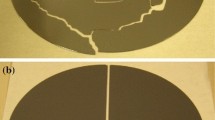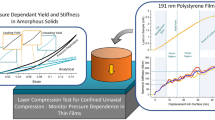Abstract
The direct exfoliation of thin films from silicon wafers has the potential to significantly lower the cost of flexible electronics while leveraging the performance benefits and established infrastructure of traditional wafer-based fabrication processes. However, controlling the thickness and uniformity of exfoliated silicon thin films has proven difficult due to a lack of understanding and control over the exfoliation process. This paper presents a new silicon exfoliation process and model which enables accurate prediction of the thickness and quality of the exfoliated thin-film based on the exfoliation process parameters. This model uses a parametric, finite element, linear elastic fracture mechanics study with nonlinear loading to determine how each process parameter affects the crack propagation depth. A metamodel is then constructed from the results of numerous simulations to inform the design and operation of a novel exfoliation tool and predict thickness of produced films. In order to manufacture uniform, high-quality films, the tool creates a controlled peeling load that is able to propagate a crack through the silicon in a controlled manner. Finally, exfoliated silicon samples produced with the prototype tool are evaluated and compared to metamodel projections, confirming the ability of the tool to steer crack trajectory within ± 3 microns of the crack depth predictions.







Similar content being viewed by others
References
Ahn J, Chou H, Banerjee SK (2017) Graphene-Al\(_{2}\)O\(_{3}\)-silicon heterojunction solar cells on flexible silicon substrates. J Appl Phys 121(16):163105. https://doi.org/10.1063/1.4981880
Bedell SW, Shahrjerdi D, Hekmatshoar B, Fogel K, Lauro PA, Ott JA, Sosa N, Sadana D (2012) Kerf–Less removal of Si, Ge, and III–V layers by controlled spalling to enable low-cost PV technologies. IEEE J Photovolt 2(2):141–147. https://doi.org/10.1109/JPHOTOV.2012.2184267
Bedell SW, Fogel K, Lauro P, Shahrjerdi D, Ott JA, Sadana D (2013a) Layer transfer by controlled spalling. J Phys D Appl Phys 46(15):152002. https://doi.org/10.1088/0022-3727/46/15/152002
Bedell SW, Shahrjerdi D, Fogel K, Lauro P, Hekmatshoar B, Li N, Ott J, Sadana DK (2013b) (Invited) cost-effective layer transfer by controlled spalling technology. ECS Trans 50(7):315–323. https://doi.org/10.1149/05007.0315ecst
Bouchard PO, Bernacki M, Parks D (2013) Analysis of stress intensity factors and T-stress to control crack propagation for kerf-less spalling of single crystal silicon foils. Comput Mater Sci 69:243–250. https://doi.org/10.1016/j.commatsci.2012.10.033
Calvez D, Roqueta F, Jacques S, Bechou L, Ousten Y, Ducret S (2014) Crack propagation modeling in silicon: a comprehensive thermomechanical finite-element model approach for power devices. IEEE Trans Compon Packag Manuf Technol 4(2):360–366. https://doi.org/10.1109/TCPMT.2013.2293094
Cannon RM, Fisher RM, Evans AG (1985) Decohesion of thin films from ceramic substrates. In: MRS proceedings, vol 54. https://doi.org/10.1557/PROC-54-799
Drory MD, Thouless MD, Evans AG (1988) On the decohesion of residually stressed thin films. Acta Metall 36(8):2019–2028
Dross F, Robbelein J, Vandevelde B, Van Kerschaver E, Gordon I, Beaucarne G, Poortmans J (2007) Stress-induced large-area lift-off of crystalline Si films. Appl Phys A 89(1):149–152. https://doi.org/10.1007/s00339-007-4195-2
Fortunato E, Barquinha P, Martins R (2012) Oxide semiconductor thin-film transistors: a review of recent advances. Adv Mater 24(22):2945–2986. https://doi.org/10.1002/adma.201103228
Janssen G, Abdalla M, van Keulen F, Pujada B, van Venrooy B (2009) Celebrating the 100th anniversary of the Stoney equation for film stress: developments from polycrystalline steel strips to single crystal silicon wafers. Thin Solid Films 517(6):1858–1867. https://doi.org/10.1016/j.tsf.2008.07.014
Kim J, Lee M, Shim HJ, Ghaffari R, Cho HR, Son D, Jung YH, Soh M, Choi C, Jung S, Chu K, Jeon D, Lee ST, Kim JH, Choi SH, Hyeon T, Kim DH (2014) Stretchable silicon nanoribbon electronics for skin prosthesis. Nat Commun 5:5747. https://doi.org/10.1038/ncomms6747
Luo J (2004) Young’s modulus of electroplated Ni thin film for MEMS applications. Mater Lett 58(17–18):2306–2309. https://doi.org/10.1016/j.matlet.2004.02.044
Masolin A, Bouchard PO, Martini R, Bernacki M (2013) Thermo-mechanical and fracture properties in single-crystal silicon. J Mater Sci 48(3):979–988. https://doi.org/10.1007/s10853-012-6713-7
Mathew L, Jawarani D (2010) Method of forming an electronic device using a separation-enhancing species. US patent US7749884B2. https://patents.google.com/patent/US7749884/en
Pagliaro M, Ciriminna R, Palmisano G (2008) Flexible solar cells. ChemSusChem 1(11):880–891. https://doi.org/10.1002/cssc.200800127
Pang C, Lee C, Suh KY (2013) Recent advances in flexible sensors for wearable and implantable devices. J Appl Polym Sci 130(3):1429–1441. https://doi.org/10.1002/app.39461
Pudasaini PR, Sharma M, Ruiz-Zepeda F, Ayon AA (2014) Ultrathin, flexible, hybrid solar cells in sub-ten micrometers single crystal silicon membrane. In: 2014 IEEE 40th photovoltaic specialist conference (PVSC). IEEE, pp 0953–0955
Rao RA, Mathew L, Saha S, Smith S, Sarkar D, Garcia R, Stout R, Gurmu A, Onyegam E, Ahn D (2011) A novel low cost 25\(\mu \)m thin exfoliated monocrystalline si solar cell technology. In: 2011 37th IEEE photovoltaic specialists conference (PVSC). IEEE, pp 001504–001507
Shahrjerdi D, Bedell SW (2013) Extremely flexible nanoscale ultrathin body silicon integrated circuits on plastic. Nano Lett 13(1):315–320. https://doi.org/10.1021/nl304310x
Shahrjerdi D, Bedell SW, Khakifirooz A, Fogel K, Lauro P, Cheng K, Ott JA, Gaynes M, Sadana DK (2012) Advanced flexible CMOS integrated circuits on plastic enabled by controlled spalling technology. In: 2012 IEEE international electron devices meeting (IEDM). IEEE, pp 5–1
Suo Z, Hutchinson JW (1989) Steady-state cracking in brittle substrates beneath adherent films. Int J Solids Struct 25(11):1337–1353. https://doi.org/10.1016/0020-7683(89)90096-6
Takei K, Takahashi T, Ho JC, Ko H, Gillies AG, Leu PW, Fearing RS, Javey A (2010) Nanowire active-matrix circuitry for low-voltage macroscale artificial skin. Nat Mater 9:821–826. https://doi.org/10.1038/nmat2835
Tanielian M, Lajos RE, Blackstone S (1986) Method of making thin free standing single crystal films US patent US4582559A. https://patents.google.com/patent/US4582559A/en?oq=+4%2c582%2c559
Thouless MD, Evans AG, Ashby MF, Hutchinson JW (1987) The edge cracking and spalling of brittle plates. Acta Metall 35(6):1333–1341. https://doi.org/10.1016/0001-6160(87)90015-0
Weil R (1970) The origins of stress in electrodeposits. Part 1. Plating 57(12):1231–1237
Xu Y, Blume JA, Shih CF (1993) An interface crack between an orthotropic thin film and substrate. Int J Fract 63(4):369–381
Ying M, Bonifas AP, Lu N, Su Y, Li R, Cheng H, Ameen A, Huang Y, Rogers JA (2012) Silicon nanomembranes for fingertip electronics. Nanotechnology 23(34):344004. https://doi.org/10.1088/0957-4484/23/34/344004
Zhai Y, Mathew L, Rao R, Xu D, Banerjee SK (2012) High-performance flexible thin-film transistors exfoliated from bulk wafer. Nano Lett 12(11):5609–5615. https://doi.org/10.1021/nl302735f
Acknowledgements
The authors acknowledge and thank Miaomiao Yang for her experience, effort, insight, and support in accomplishing this work. The authors thank Kirsten Cole Christopherson for her effort in completing these experiments. The authors would also like to thank Liam Conolly, Dipankar Behera, and Cheng Zhao for the informative discussions and technical expertise. This work is based upon work supported primarily by the National Science Foundation under Cooperative Agreement No. EEC-1160494. Any opinions, findings and conclusions or recommendations expressed in this material are those of the author(s) and do not necessarily reflect the views of the National Science Foundation.
Author information
Authors and Affiliations
Corresponding author
Additional information
Publisher's Note
Springer Nature remains neutral with regard to jurisdictional claims in published maps and institutional affiliations.
Rights and permissions
About this article
Cite this article
Ward, M., Cullinan, M. A fracture model for exfoliation of thin silicon films. Int J Fract 216, 161–171 (2019). https://doi.org/10.1007/s10704-019-00350-4
Received:
Accepted:
Published:
Issue Date:
DOI: https://doi.org/10.1007/s10704-019-00350-4




